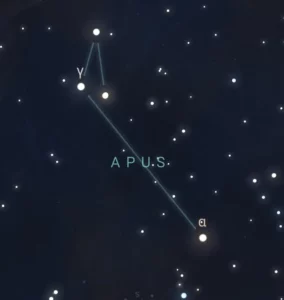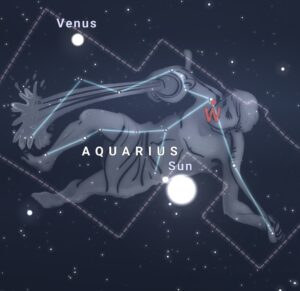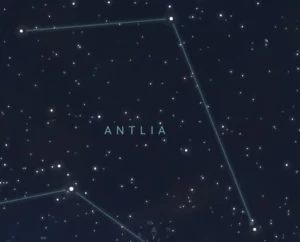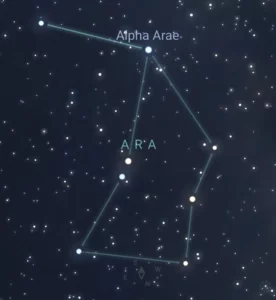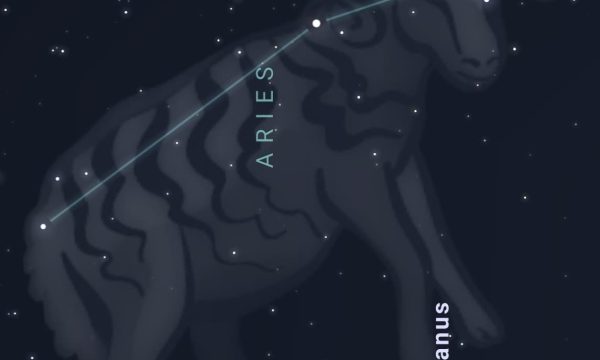
Constellation Aries
A rather inconspicuous northern zodiac constellation, which honors the ram whose golden fleece was sought by Jason and the Argonauts.
Aries used to contain the vernal equinox, the point where the Sun crosses the celestial equator. Nowadays the vernal equinox has moved in the constellation Pisces, but sometimes it is still called the first point of Aries.
The constellation can be seen from latitudes between +90° and -60°, and is best visible in the winter.
Abbreviation: Ari Genitive: Arietis English name: The ram
Notable Stars in Aries
Alpha Arietis (Hamal) – Second magnitude Hamal translates into “The head of the sheep”, and is the brightest star of the constellation. It shines with a reddish color and is some 55 times brighter and five times more massive than our Sun.
Beta Arietis (Sheratan) – Beta shines at magnitude 2.7 and it is located 60 light years from Earth. In the early 1900’s it was discovered to be a spectroscopic binary, with a period of 106 days.
Gamma Arietis (Mesarthim) – An easy, wide, double star with bluish components shining both at magnitude 4.6. Binoculars will not split it, but almost any small telescope will do so.
Gamma Arietis is one of the first double stars to be discovered, found in 1664 by the English scientist Robert Hooke while he was searching for a comet.
Lambda Arietis – A binary star easily split with binoculars into its components of magnitudes 5 and 7. It is approximately 133 light years from Earth.
Pi Arietis – A blue-white double star shining at 5th magnitude. The companion is 3 arcseconds away and has an apparent magnitude of 8.8. Because the separation between the components is so small, Pi Arietis is quite a difficult binary for small telescopes. Use the highest magnification your telescope can give when observing this star.
30 Arietis – A wonderful double star for small telescopes! The brighter star shines at magnitude 6.6 and at high magnification it shows a distinct yellow color. The bluish companion is magnitude 7.4, 40 arcseconds away.
53 Arietis – Fifth magnitude 53 Arietis is a “Runaway star”, characterized by a high space velocity and a large proper motion through the sky. Together with the two other “Runaway stars” (AE Aurigae and Mu Columbae), 53 Arietis appears to be moving outward from the region of the Great Orion Nebula.
It seems that all these three stars where ejected from the nebula, possibly by the explosions of supernovae.
Notable Deep Sky Objects in Aries
NGC 772 – A faint spiral galaxy visible with a 4.5-inch telescope as a small hazy patch only 5×3 arcminutes across. Users of larger telescopes might notice a spiral arm in the northwestern part of the galaxy.
Meteor Showers
Although it lacks bright stars and deep sky objects, Aries is home to a large number of meteor showers. Unfortunately, none of these showers are of great interest for amateur astronomers.
The May Arietids are a daylight meteor shower active between May 4th and June 6th. Maximum activity occurs on May 16th from a radiant located seven degrees southeast of Alpha Arietis.
The Epsilon Arietids are also a daylight shower. The period of activity spans from April 25th to May 27th, reaching the maximum on May 9th.
The shower of the Daytime-Arietids is active from May 22nd to July 2nd. Peak activity occurs around June 8th, when the shower produces one meteor every minute.
The Delta Arietids shower was discovered in 1959 by analyzing photographic meteor orbits. It can be observed visually, and seems to be active from December 8th to December 13th.
The duration of the Autumn Arietids meteor shower extends from September 7th to October 27th. Maximum activity occurs around October 8th, when three to five shower members can be seen every hour.

Emil, an avid astronomy writer, formerly owned and ran nightskyinfo.com, making the universe more comprehensible for his readers. He has recently handed over its reins to Tom Urbain from starlust.org, ensuring that his legacy of simplifying the stars continues to enlighten and inspire.
Discover More Constellations 🌌
This page is part of our collection of constellation articles. If you enjoyed the read, then you’ll love the following articles.

